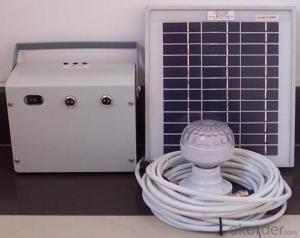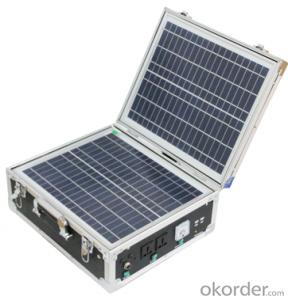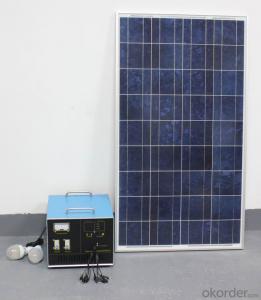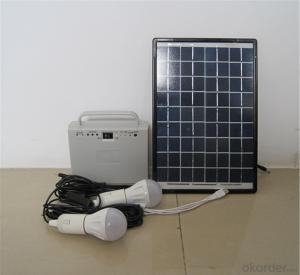Solar Portable System AN-S50W
- Loading Port:
- Shanghai
- Payment Terms:
- TT OR LC
- Min Order Qty:
- 0 set
- Supply Capability:
- 10000 set/month
OKorder Service Pledge
OKorder Financial Service
You Might Also Like
Item specifice
Description of Solar Portable System AN-S50W
Compatible portable solar power supply, also called solar mobile power, it includes: solar panel, charge controller, discharge controller, electric charge controller, inverter, outside enlarge capacity interface and battery, etc. Photovoltaic portable power supply can work in solar energy and ordinary power two modes, and can automatically switch. Photovoltaic portable power supply is used widely is the emergency relief, tourism, army, geological prospecting, archaeology, schools, hospitals, Banks, gas stations, comprehensive building, highway, substation, family camping or outdoor activities such as emergency power ideal power supply equipment.
Specifications of Solar Portable System AN-S50W
1. Solar Panel: 50W 18V
2. Battery: 12V20AH lead-acid battery
Input terminal: 1 DC input, 14.8V; 2 solar input terminal (+,-), 18V.
Output terminal: 8 output terminals, including:
1x USB output, 5V 1A;
5x DC outputs, 12V 1A;
2xAC220V outputs
Switch: 2pcs; left one for DC12V, right one for AC220V
Indication lamp: 2 pcs; Red one is for charging indication, Green one is for operating indication.
Accessories of Solar Portable System AN-S50W
1. 2pcs 3W led bulbs;
2. 1pc 5m connection wire between solar panel and cabinet;
3. 2pcs lamp holder with 3m wire;
4. 1pc AC charger
Technical Data of Solar Portable System AN-S50W
| Internal Package Size (cm) | 36*24*26 (panel extra) |
| Packing QTY | 1 |
| External Package Size (cm) | 36*24*26 (panel extra) |
IMages of Solar Portable System AN-S50W
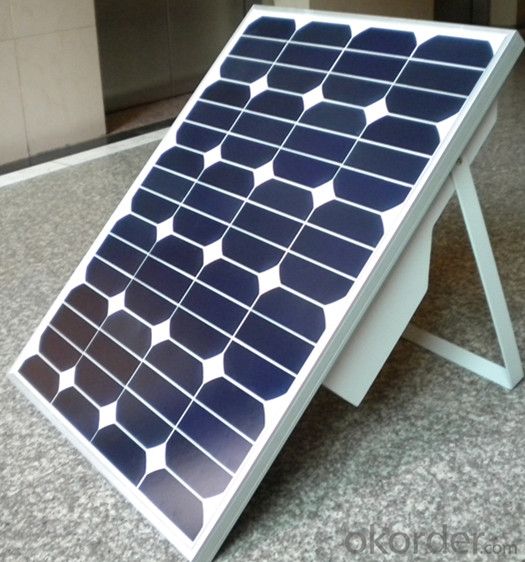

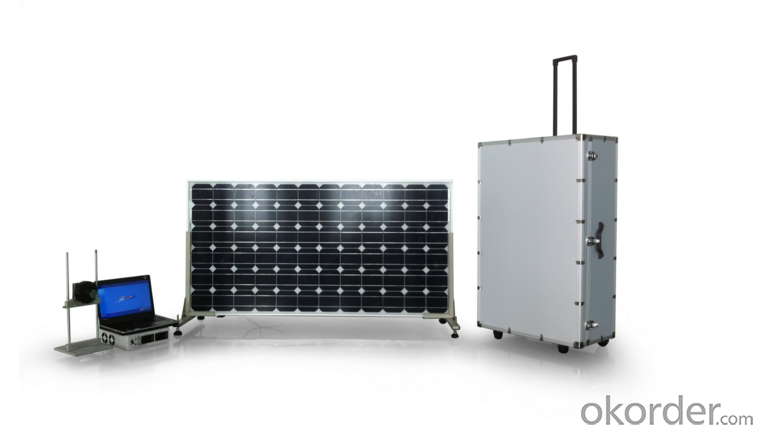
FAQ:
1. How long will my inquiry get response?
Your inquiry related to our products or prices will be replied within 24 hours.
2. Can I get professional service and suggestion?
Well-trained and experienced staffs to answer all your questions in fluent English.
3. Do you accept OEM or customized design?
OEM & ODM, any your customized lightings we can help you to design and put into product.
4. What if I need specific design?
Distributorship are offered for your unique design and some our current models.
- Q:Can solar energy systems be used for powering electric vehicle solar charging stations at airports?
- Yes, solar energy systems can definitely be used for powering electric vehicle (EV) solar charging stations at airports. Solar panels can be installed on the roofs of parking structures or on the ground near the charging stations to capture sunlight and convert it into electricity. This electricity can then be used to power the EV charging stations, providing a clean and sustainable source of energy. Using solar energy to power EV charging stations at airports offers several benefits. Firstly, it reduces the reliance on fossil fuels and decreases greenhouse gas emissions, contributing to a more sustainable and environmentally friendly transportation system. Secondly, it helps airports meet their renewable energy goals and reduce their carbon footprint. Additionally, solar-powered charging stations can provide a reliable source of electricity even during power outages or grid failures, ensuring uninterrupted charging services for electric vehicles. Moreover, airports are typically large open spaces with ample sunlight, making them ideal locations for solar installations. With proper planning and design, solar panels can be integrated seamlessly into the airport infrastructure, maximizing the energy generation potential. This can help airports become more energy independent and reduce their operating costs by generating their own electricity. In conclusion, solar energy systems are a viable and effective solution for powering electric vehicle solar charging stations at airports. By harnessing the power of the sun, airports can provide clean and sustainable energy for EVs, contributing to a greener transportation system and a more sustainable future.
- Q:What is solar tracking and how does it improve system efficiency?
- Solar tracking refers to the mechanism used to orient solar panels towards the sun to maximize their exposure and energy capture. By continuously adjusting the position of the panels throughout the day, solar tracking ensures that they are always facing the sun directly, optimizing their absorption of sunlight. This improves system efficiency as it maximizes the solar energy harvested by the panels, resulting in increased electricity production compared to fixed panel systems.
- Q:How does the efficiency of solar panels vary across different installation locations?
- The efficiency of solar panels varies across different installation locations due to various factors such as the amount of sunlight received, the angle and orientation of the panels, shading, temperature, and local weather conditions.
- Q:How does the efficiency of solar panels vary with different weather conditions?
- The efficiency of solar panels can vary significantly depending on the weather conditions. Solar panels convert sunlight into electricity, and therefore, their efficiency is directly affected by the amount of sunlight they receive. On a clear and sunny day, solar panels operate at their peak efficiency since they receive the maximum amount of sunlight. The direct sunlight allows for optimal conversion of solar energy into electricity, resulting in higher efficiency. However, during cloudy or overcast days, the efficiency of solar panels decreases. This is because clouds block a significant portion of the sunlight, reducing the amount of energy available for conversion. While solar panels can still generate electricity under cloudy conditions, their efficiency is considerably lower compared to sunny days. Temperature is another weather factor that affects solar panel efficiency. Contrary to popular belief, solar panels actually work more efficiently in cooler temperatures. As the temperature increases, the performance of solar cells decreases due to a phenomenon called the temperature coefficient. High temperatures reduce the voltage output of solar panels, leading to lower efficiency. Rain or snowfall can also impact the efficiency of solar panels, although the effect is relatively minimal. Rain can temporarily decrease the efficiency by reducing the amount of sunlight reaching the panels, but once the rain stops, they return to their normal efficiency. Snow, on the other hand, can cover the panels and prevent sunlight from reaching them, resulting in a temporary loss of efficiency until the snow is cleared. In summary, the efficiency of solar panels varies with different weather conditions. Clear and sunny days provide optimal conditions for maximum efficiency, while cloudy or overcast days result in decreased efficiency. Temperature fluctuations can also impact the performance of solar panels, with higher temperatures leading to lower efficiency. Rain and snow can temporarily reduce efficiency, but their overall impact is relatively minor.
- Q:How often do solar panels need to be cleaned or maintained?
- Solar panels typically require minimal maintenance and cleaning. In most cases, they only need to be cleaned once or twice a year, depending on the location and climate. Regular inspections and light cleaning can help ensure optimal performance and efficiency of solar panels.
- Q:Can solar energy systems be used in areas with limited access to solar energy advocacy groups?
- Yes, solar energy systems can still be used in areas with limited access to solar energy advocacy groups. While the presence of advocacy groups can provide additional resources and support, the feasibility of installing and utilizing solar energy systems depends primarily on the availability and intensity of sunlight in the given area. If the region receives sufficient sunlight, individuals or communities can still adopt solar energy independently, even without the presence of advocacy groups. The use of solar energy systems can help reduce reliance on traditional energy sources, lower electricity costs, and contribute to a more sustainable future.
- Q:What is the impact of roof material on the performance of solar panels?
- The impact of roof material on the performance of solar panels is significant and should not be overlooked. The choice of roof material can greatly affect the efficiency and overall output of the solar panel system. Firstly, the color and reflectivity of the roof material can influence the performance of solar panels. Dark-colored roofs tend to absorb more heat, which can increase the temperature of the solar panels. High temperatures can decrease the efficiency of the panels and reduce their output. On the other hand, light-colored or reflective roofs can help to keep the panels cooler, allowing them to operate more efficiently. Secondly, the texture and material of the roof can affect the installation and positioning of the solar panels. Some roofing materials, such as slate or clay tiles, can be more fragile and require additional care and expertise during the installation process. Flat or smooth roofs made of materials like metal or asphalt make it easier to mount solar panels and adjust their tilt and orientation to maximize solar exposure. Furthermore, the durability and lifespan of the roof material should also be considered. Solar panels typically have a lifespan of 25 to 30 years or more. It is important to choose a roof material that can withstand the weight and potential impact of the solar panel system over its lifetime. Additionally, roof materials that require frequent maintenance or replacement may disrupt the solar panel system and incur additional costs. Lastly, the roof material can impact the overall aesthetics and integration of the solar panel system into the building's design. Different roof materials may require specific mounting systems or modifications, which can affect the visual appeal of the solar installation. It is important to choose a roof material that complements the appearance of the solar panels and enhances the overall look of the building. In conclusion, the impact of roof material on the performance of solar panels is significant. The choice of roof material can affect the temperature, installation, durability, and aesthetics of the solar panel system. It is crucial to carefully consider these factors to ensure optimal performance and longevity of the solar panels.
- Q:Can solar energy systems be used in areas with limited access to technical expertise?
- Yes, solar energy systems can be used in areas with limited access to technical expertise. The design and installation of solar energy systems have become increasingly user-friendly and accessible over time. There are now simplified and plug-and-play solar kits available that can be easily installed and maintained by individuals with limited technical knowledge. Additionally, organizations and initiatives are providing training and educational resources to empower local communities in these areas to adopt and manage solar energy systems effectively.
- Q:How much sunlight is needed for a solar energy system to be effective?
- A solar energy system can be effective with as little as 4-5 hours of direct sunlight per day, although more sunlight will generally result in higher energy production.
- Q:How much does it cost to install a solar energy system?
- The cost of installing a solar energy system can vary depending on several factors such as the size of the system, location, and specific project requirements. On average, residential solar installations can cost anywhere between $15,000 to $25,000 or more. However, it's important to note that there are also various financial incentives, tax credits, and financing options available that can help offset the initial cost and make solar energy more affordable for homeowners and businesses.
1. Manufacturer Overview |
|
|---|---|
| Location | |
| Year Established | |
| Annual Output Value | |
| Main Markets | |
| Company Certifications | |
2. Manufacturer Certificates |
|
|---|---|
| a) Certification Name | |
| Range | |
| Reference | |
| Validity Period | |
3. Manufacturer Capability |
|
|---|---|
| a)Trade Capacity | |
| Nearest Port | |
| Export Percentage | |
| No.of Employees in Trade Department | |
| Language Spoken: | |
| b)Factory Information | |
| Factory Size: | |
| No. of Production Lines | |
| Contract Manufacturing | |
| Product Price Range | |
Send your message to us
Solar Portable System AN-S50W
- Loading Port:
- Shanghai
- Payment Terms:
- TT OR LC
- Min Order Qty:
- 0 set
- Supply Capability:
- 10000 set/month
OKorder Service Pledge
OKorder Financial Service
Similar products
New products
Hot products
Related keywords
